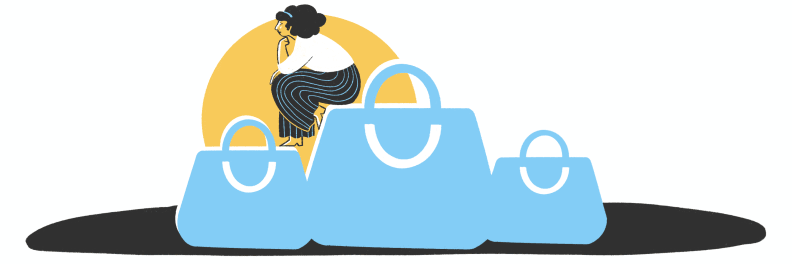Ready to quit fast fashion? Change your algorithm.
De-influence yourself from a constant cycle of consumption
 Credit:
Reviewed / Tara Jacoby
Credit:
Reviewed / Tara Jacoby
Products are chosen independently by our editors. Purchases made through our links may earn us a commission.
With haul culture, micro-trends, and fashion creators constantly recommending the best new products to buy, it’s no surprise that purchasing fast fashion has become second nature to many consumers. Social Media can be a vessel for education, communication, and (not to be dramatic) transforming your life. Fast fashion companies are aware of the potential of social media to be used as a tool, and they use it to constantly bombard us with an ever-growing mountain of clothes, whilst having zero regard for garment workers or the planet.
Welcome back to our series on quitting fast fashion, where we are tackling the giant that is fast fashion and slowly unsubscribing ourselves from the grips of unsustainable fashion. We've already discussed the importance of organizing our wardrobes, but now it’s time to diagnose our social media feeds. Today, it seems that nearly every new post on the internet is a marketing tool, and this can have a huge impact on how often we purchase fast fashion. It’s time that the rules changed and we align our feeds with conscious fashion goals.
We chatted with Sara Leeds, creative director, host, and sustainable fashion content creator, and Aditi Mayer, sustainable fashion blogger, photojournalist, and labor rights activist, to understand the influence content has on us and our relationship to fast fashion.
Step 1: Diagnose

Want to end your dependency on fast fashion? Start by rethinking how you consume media.
How often are you served hauls and unboxing videos, and outfit photos tagged with numerous brands? Each new post introduces us to another article of clothing. This constant stimulation can either leave you inspired to style your own pieces, or more problematically—fill your wardrobe with new things. And if spending time online results in a visit to Zara or H&M’s website, it's time to rethink your algorithm.
“I’m all for whatever we want to consume on social media,” says Leeds. “If you enjoy it and want to watch it, then watch it. If something like a haul is inspiring to you, or entertaining to you, and you want to keep consuming that content, then by all means, go ahead. I would just challenge you to say, ‘Okay, I'm going to consume this because I enjoy it. But I'm no longer going to let it influence my purchasing habits and my time spent outside of these apps.’”
Social media platforms have ultimately become a marketplace, with shopping links embedded directly into the posts themselves and a plethora of products being displayed in feeds and in stories. Is your feed filled with other people's purchases or shopping-related content? If the answer is yes, then I encourage you to keep reading. Just because we consume fashion and shopping content, doesn’t mean we should allow it to have any autonomy over our lives and our wallets. The next time you pick up your phone to scroll, set a timer for 10 minutes and make a tally of how many posts incorporate an ad or shoppable element. If over 50% of your feed is persuading you to purchase, keep reading.
Step 2: Reflect

Once you've diagnosed the issue, reflect on how you engage with fashion on social media.
After identifying what types of content you’re being fed, you may have a better understanding of how social media can impact how often you’re being influenced to purchase a new pair of shoes or articles of clothing. Now that you know that the vast majority of social content is asking you to buy something new, ask yourself how you often give in and make the purchase. Are you able to view an ad and only acknowledge the beauty of a product, or an influencer's style, or simply admire the article of clothing? If you can’t scroll through social media without saving a post or adding to cart with the intention to purchase, then it is definitely time to make a change.
This may be overwhelming, but identifying the impact it has on you is an achievement in itself. “Applaud yourself for the fact that you've even come to this realization. That is a huge accomplishment because so many people don't. Be gentler with yourself and have the perspective that you as an individual consumer can change your habits,” encourages Leeds.
“There are a lot of amazing fashion girls on the internet that are propagating the idea that you must have this and must have that. But that is where the individual really needs to step in and consider their relationship with how they're going to consume,” says Mayer. She continues, “We have agency over who we follow and it demands an individual to consider how sensitive they are to certain marketing messages. If you find yourself feeling the need to impulse buy as a result of the content you consume, that's where the personal self-awareness piece comes in.”
Knowing that we are persuaded too easily by 30-second videos can feel incredibly overwhelming. But don’t let your reflection time lead you into a spiral. Fast fashion companies have little regard for people and the planet so it’s our turn to ignore them entirely.
Step 3: Redirect

Now that you've identified the problem, you can begin to find a solution.
Now that we’ve identified our current algorithm and reflected on its impact, we will need to redirect our attention elsewhere. And why not redirect it to the brands that deserve it?
Engaging with less media and investing in pieces that you know you’ll re-wear is the key element to slowing down. “The alternative to fast fashion is a slower reimagined approach to fashion, which isn't about reinventing the wheel,” says Mayer. “So much of my work is focuses on homegrown brands that are inherently antithetical to the fast fashion model, and actively seeking those types of brands is a really beautiful way to have a more intimate relationship with the things you buy, while actively learning about the processes that inform how something is made.”
If you can’t make the switch from fast to slow fashion instantly, slowly redirect your attention and your spending. “Don't go cold turkey because you’ll feel like you're depriving yourself in some sense, I would much rather encourage small but meaningful and gradual changes. If you go to Zara once a week, maybe start going twice a month, or if you spend $1,000 a month on clothing, maybe start with $750 a month and then in two months' time get down to $500 and then in another two months time take it down to $250. Make these gradual changes and hold yourself accountable to them.” Leeds continues, “I would just challenge you to start reflecting on if fast fashion is the only place you genuinely want your money to go to.”
Step 4: Engage with conscious creators and accounts

Reprogram your "For You" page to serve you content from conscious fashion brands and influencers.
Quitting fast fashion doesn’t mean not engaging with fashion online. As Leeds stated, we can enjoy style content without permitting it to dictate our actions. However, if consuming fashion content, whether fast fashion or not, urges you to make instant purchases, I suggest you try pivoting your online content entirely. “Begin searching different terms; thinking of other topics that might interest you,” encourages Leeds. “Start liking content from different niches as well. And then over time, your algorithm will unlearn content that it has historically served to you and start to pivot into other interests.”
There is also a whole side of the internet that is dedicated to conscious and slow fashion choices you just need to know where to look. Below are a few of our favorite Instagram accounts that provide educational, conscious fashion-focused content to get you started.
Instagram accounts to follow
- @remakeourworld
- @nokillmag
- @thegoodtrade
- @sustainthemag
- @slowfashion.movement
- @goodonyou_app
- @consciousfashion


